Introduction
Scotland is one of the best places in the world for stargazing, thanks to its low levels of light pollution, vast open landscapes, and remote wilderness. The country is home to some of Europe’s darkest skies, offering breathtaking views of the Milky Way, planets, shooting stars, and even the Northern Lights.
From designated Dark Sky Parks to island observatories, Scotland provides stargazers with a magical night-sky experience. Whether you’re an astronomy enthusiast or simply someone who loves the wonder of the universe, this guide will take you through the best stargazing locations, tips for spotting celestial wonders, and must-visit observatories in Scotland.
1. Scotland’s Best Dark Sky Locations
Galloway Forest Park: Scotland’s First Dark Sky Park
- The UK’s first official Dark Sky Park, designated in 2009.
- Recognized as one of Europe’s darkest places, where the Milky Way can be seen with the naked eye.
- Offers stargazing trails and public observatories, including the Scottish Dark Sky Observatory.
Best spots for stargazing in Galloway Forest Park:
- Clatteringshaws Loch – A peaceful loch with wide-open skies.
- Glentrool Visitor Centre – A great location for beginners with star maps available.
- Kirroughtree Visitor Centre – Hosts stargazing events and astronomy workshops.
Cairngorms National Park: A Mountain Stargazing Paradise
- Scotland’s largest national park and an excellent location for high-altitude stargazing.
- The high mountains reduce light pollution, making it ideal for viewing deep-sky objects.
- Loch Morlich Beach offers a stunning setting for watching stars reflecting on the water.
Isle of Skye: The Dark Sky Island
- Known for its rugged landscapes and minimal artificial light, making it a top stargazing destination.
- The best locations on Skye for stargazing include:
- The Quiraing – Offers dramatic landscapes under a starry sky.
- Neist Point Lighthouse – A perfect coastal spot for spotting the Northern Lights.
- The Fairy Pools – A mystical setting for night-sky photography.
The Outer Hebrides: Scotland’s Remote Stargazing Haven
- Due to its isolation and minimal human activity, the Outer Hebrides is a dream destination for astronomers.
- The best places for stargazing include:
- Callanish Standing Stones (Isle of Lewis) – A magical place to witness the stars among ancient monoliths.
- Traigh Mhor Beach (Barra) – Offers clear views of meteor showers and the Milky Way.
Moffat: Scotland’s First Dark Sky Town
- The first town in Europe to achieve Dark Sky status by controlling artificial light pollution.
- Streetlights use special low-glow technology, preserving the natural night sky.
- The Moffat Community Observatory offers guided stargazing sessions and telescope access.
2. What You Can See in Scotland’s Dark Skies

The Milky Way
- Easily visible from any Dark Sky location, especially on moonless nights.
- Best time: September to March, when the sky is at its darkest.
The Northern Lights (Aurora Borealis)
- Scotland is one of the best places in the UK to see the Northern Lights, locally known as the “Mirrie Dancers”.
- Best time: Autumn and winter months (October to March).
- Best locations: Caithness, Orkney, Shetland, and the Isle of Skye.
Meteor Showers
- Scotland’s clear skies make meteor watching spectacular.
- Key meteor showers to watch:
- Perseids (August) – One of the brightest meteor showers.
- Geminids (December) – Produces up to 120 meteors per hour.
Planets and Constellations
- Scotland’s dark skies allow for excellent views of Saturn’s rings, Jupiter’s moons, and Mars’ red glow.
- Orion, Ursa Major, and Cassiopeia are some of the most visible constellations.
3. Scotland’s Top Observatories and Stargazing Events

Scottish Dark Sky Observatory (Galloway Forest Park)
- Located in one of the darkest parts of Scotland, offering public telescope viewing sessions.
- Features a 16-inch research-grade telescope, ideal for viewing distant galaxies.
Kielder Observatory (Near the Scottish Border)
- One of the UK’s most advanced observatories, located in a Dark Sky Reserve.
- Hosts stargazing workshops, photography nights, and beginner astronomy classes.
Isle of Coll: Scotland’s Dark Sky Island
- One of only two Dark Sky Islands in the world.
- Hosts Coll & the Cosmos, an annual astronomy festival.
- Offers guided stargazing tours and telescope access.
Dark Skies Festivals in Scotland
- Hebridean Dark Skies Festival (Outer Hebrides, February) – A celebration of astronomy, featuring talks, music, and telescope sessions.
- Moray’s Astronomy Festival – Features stargazing cruises, planetarium shows, and night-sky photography workshops.
4. Tips for Stargazing in Scotland

Best Time for Stargazing
- Autumn and Winter (October–March) – The nights are longer and darker, making it easier to see stars, planets, and the Northern Lights.
- New Moon Phases – The sky is at its darkest, providing the best conditions for stargazing.
Essential Gear for Stargazing
- A telescope or binoculars – Helps you spot planets and distant galaxies.
- A star map or stargazing app – Guides you to constellations and celestial objects.
- A red torch – Preserves your night vision while navigating in the dark.
- Warm clothing and blankets – Scottish nights can be cold, even in summer.
How to Capture Stunning Night-Sky Photos
- Use a DSLR camera with a wide aperture lens.
- Set your camera to a long exposure (15-30 seconds) to capture faint stars and the Milky Way.
- Use a tripod to keep your camera steady.
Conclusion
Scotland is a stargazer’s paradise, offering some of the darkest skies in Europe and incredible celestial views. Whether you want to see the Northern Lights over the Isle of Skye, watch the Milky Way shine over Galloway Forest Park, or visit Scotland’s top observatories, there’s a perfect spot for every astronomy lover.
So, grab a telescope, pack a warm jacket, and get ready to explore Scotland’s breathtaking night skies like never before!












